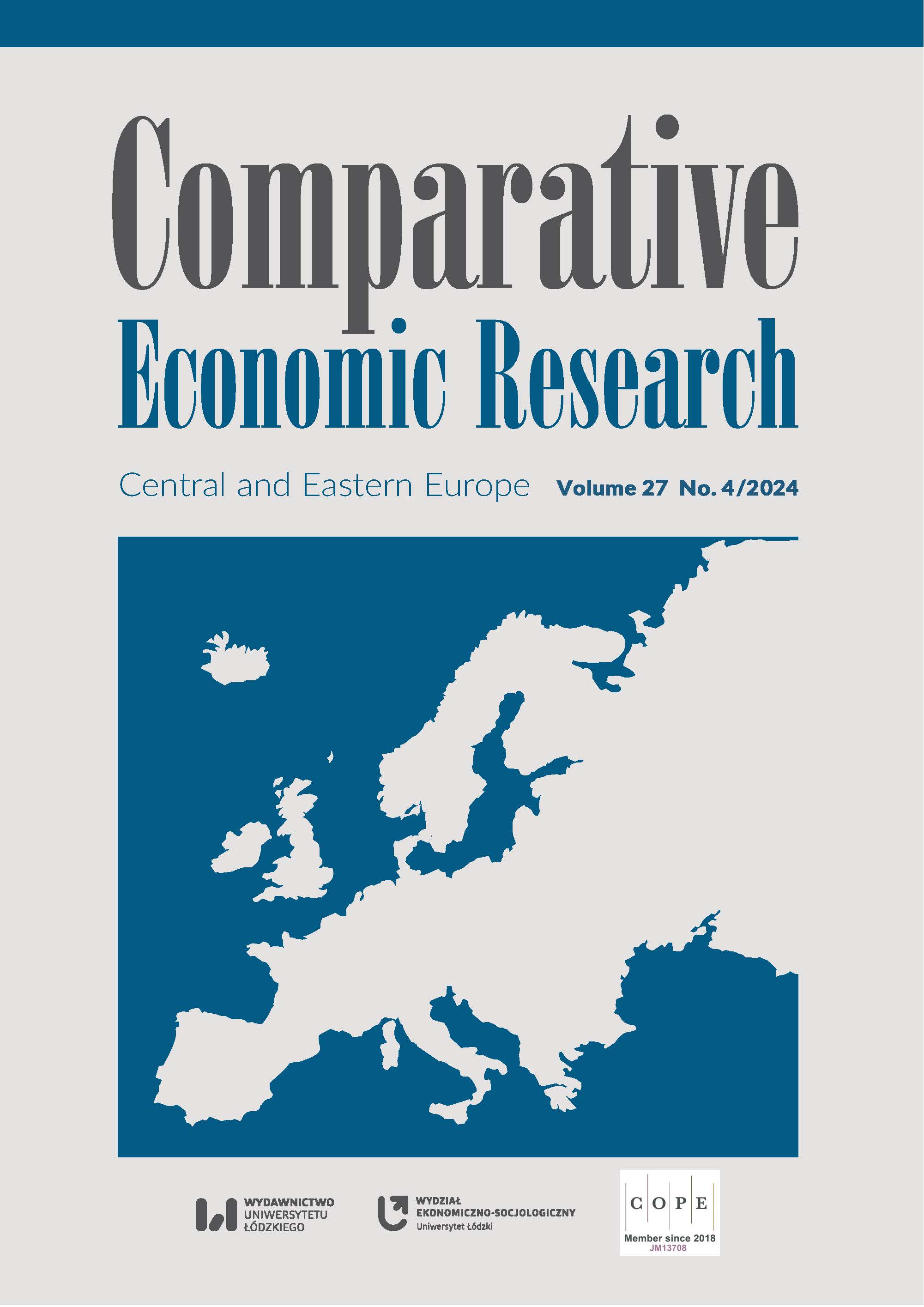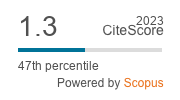Exploring Income Convergence for Central and South Asia
DOI:
https://doi.org/10.18778/1508-2008.27.32Keywords:
income convergence, economic integration, Central Asia, South AsiaAbstract
Income convergence refers to the idea that poor countries grow more quickly than rich ones and catch up in terms of per capita income; as a result, the per capita income of integrated nations eventually converges. Beta convergence suggests that less developed nations grow more quickly than more developed ones and reach their average per capita income level by growing more quickly. Meanwhile, sigma convergence suggests that the per capita income disparity among the countries in a regional block narrows over time.
The objective of this study is to test income convergence through beta and sigma convergence for Central and South Asia integration using data from 1990 to 2022. Sigma convergence is tested through the standard deviation and coefficient of variation of average per capita income, while beta convergence is tested using panel unit root tests. The results of the study confirm the beta convergence and sigma convergence, which implies income convergence for the integration of Central and South Asia.
The implications of this study are manifold. It recommends that Central and South Asian countries ensure economic, political and social cooperation with one another. This is possible by eliminating trade restrictions and decreasing import taxes to increase free trade. Additionally, ensuring free labor, capital, and technology movement between Central and South Asia will be beneficial for ensuring economic integration, facilitating income convergence, and reducing income inequality between these regions. This study contributes to the income convergence literature by focusing on integration between Central Asia and South Asia.
Downloads
References
Ahmed, Z.S., Hussain, M. (2019), Lessons from the European Union’s Economic Integration for South Asian Regionalism, “Journal of Developing Societies”, 35 (3), pp. 325–345, https://doi.org/10.1177/0169796X19865675
Google Scholar
DOI: https://doi.org/10.1177/0169796X19865675
Alinsato, A.S. (2022), Regional Integration in the West African Economic and Monetary Union (WAEMU): Complementarity or Competition?, “Economies”, 10 (1), pp. 22–34, https://doi.org/10.3390/economies10010022
Google Scholar
DOI: https://doi.org/10.3390/economies10010022
Barro, R.J. (1991), Economic Growth in a Cross Section of Countries, “The Quarterly Journal of Economics”, 106 (2), pp. 407–443, http://hdl.handle.net/10.2307/2937943 (accessed: 16.10.2023).
Google Scholar
DOI: https://doi.org/10.2307/2937943
Baumol, W. (1986), Productivity Growth, Convergence, and Welfare: What the Long‑Run Data Show, “American Economic Review”, 76 (5), pp. 1072–1085, https://www.jstor.org/stable/1816469 (accessed: 18.11.2023).
Google Scholar
Bernard, A.B., Durlauf, S.N. (1995), Convergence in international output, “Journal of Applied Econometrics”, 10 (2), pp. 97–108, https://doi.org/10.1002/jae.3950100202
Google Scholar
DOI: https://doi.org/10.1002/jae.3950100202
Bishwakarma, J.K., Hu, Z. (2022), Problems and prospects for the South Asian Association for Regional Cooperation (SAARC), “Politics & Policy”, 50 (1), pp. 154–179, https://doi.org/10.1111/polp.12443
Google Scholar
DOI: https://doi.org/10.1111/polp.12443
Cass, D. (1965), Optimum Growth in an Aggregative Model of Capital Accumulation, “The Review of Economic Studies”, 32 (3), pp. 233–240, https://doi.org/10.2307/2295827
Google Scholar
DOI: https://doi.org/10.2307/2295827
Cheong, I., Turakulov, V. (2022), How is Central Asia to Escape from trade isolation? Policy‑targeted scenarios by CGE modeling, “The World Economy”, 45 (8), pp. 2622–2648, https://doi.org/10.1111/twec.13195
Google Scholar
DOI: https://doi.org/10.1111/twec.13195
Choi, I. (2001), Unit root tests for panel data, “Journal of International Money and Finance”, 20 (2), pp. 249–272, https://doi.org/10.1016/S0261-5606(00)00048-6
Google Scholar
DOI: https://doi.org/10.1016/S0261-5606(00)00048-6
Dawson, J.W., Strazicich, M.C. (2010), Time‑series tests of income convergence with two structural breaks: evidence from 29 countries, “Applied Economics Letters”, 17 (9), pp. 909–912, https://doi.org/10.1080/13504850802584807
Google Scholar
DOI: https://doi.org/10.1080/13504850802584807
Dendrinos, D.S., Sonis, M. (1990), Socio‑Spatial Dynamics, [in:] D.S. Dendrinos, M. Sonis, Chaos and Socio‑Spatial Dynamics, Springer, New York, pp. 4–23, https://doi.org/10.1007/978-1-4612-0991-1
Google Scholar
DOI: https://doi.org/10.1007/978-1-4612-0991-1_2
Dey, S.P., Neogi, D. (2015), Testing Sigma and Unconditional Beta Convergence of GDP for SAARC Countries: Can Inclusion of China further Consolidate the Convergence?, “Global Business Review”, 16 (5), pp. 845–855, https://doi.org/10.1177/0972150915591643
Google Scholar
DOI: https://doi.org/10.1177/0972150915591643
Enders, W., Lee, J. (2004), Testing for a Unit‑root with a Non Linear Fourier Function, “In Econometric Society 2004 Far Eastern Meetings”, 457, pp. 1–47, https://www.researchgate.net/profile/Junsoo‑Lee-3/publication/4816436_Testing_for_a_Unitroot_with_a_Non_Linear_Fourier_Function/links/5757caef08ae04a1b6b69836/Testing‑for‑a‑Unit‑root‑with‑a‑Non‑Linear‑Fourier‑Function.pdf (accessed: 16.10.2023).
Google Scholar
Fedajev, A., Radulescu, M., Babucea, A.G., Mihajlovic, V., Yousaf, Z., Milićević, R. (2022), Has COVID–19 pandemic crisis changed the EU convergence patterns?, “Economic Research – Ekonomska Istraživanja”, 35 (1), pp. 2112–2141, https://doi.org/10.1080/1331677X.2021.1934507
Google Scholar
DOI: https://doi.org/10.1080/1331677X.2021.1934507
Gammadigbe, V. (2021), Is Regional Trade Integration a Growth and Convergence Engine in Africa?, “IMF Working Paper”, WP/21/19, https://www.imf.org/‑/media/Files/Publications/WP/2021/English/wpiea2021019‑print‑pdf.ashx (accessed: 8.11.2023).
Google Scholar
DOI: https://doi.org/10.5089/9781513567716.001
Gul, H., Haq, I., Khan, D. (2022), Exploring Intra‑Group Income Convergence for the Central Asian Countries, “IRASD Journal of Economics”, 4 (3), pp. 448–461, https://doi.org/10.52131/joe.2022.0403.0092
Google Scholar
DOI: https://doi.org/10.52131/joe.2022.0403.0092
Haider, A., Hameed, S., Wajid, A. (2010), Income Convergence Hypothesis: A Regional Comparison of Selected East and South Asian Economies, “Munich Personal RePec Archive”, Paper No. 23739, https://mpra.ub.uni‑muenchen.de/23739/ (accessed: 15.11.2023).
Google Scholar
Hu, G.H., Lau, C.K.M., Lu, Z., Sheng, X. (2022), Why participate in the “One Belt and One Road” initiative? An income convergence approach, “The Singapore Economic Review”, 67 (04), pp. 1209–1223, https://doi.org/10.1142/S0217590818500297
Google Scholar
DOI: https://doi.org/10.1142/S0217590818500297
Im, K.S., Pesaran, M.H., Shin, Y. (2003), Testing for unit roots in heterogeneous panels, “Journal of Econometrics”, 115 (1), pp. 53–74, https://doi.org/10.1016/S0304-4076(03)00092-7
Google Scholar
DOI: https://doi.org/10.1016/S0304-4076(03)00092-7
Islam, M.S. (2022), Does the trade‐led growth hypothesis exist for South Asia? A pooled mean group estimation, “Regional Science Policy & Practice”, 14 (2), pp. 244–257, https://doi.org/10.1111/rsp3.12481
Google Scholar
DOI: https://doi.org/10.1111/rsp3.12481
Islam, N. (2003), What have We Learned from the Convergence Debate?, “Journal of Economic Surveys”, 17 (3), pp. 309–362, https://doi.org/10.1111/1467-6419.00197
Google Scholar
DOI: https://doi.org/10.1111/1467-6419.00197
Khan, G., Daly, V. (2018), Growth Convergence and Divergence in SAARC, “Research in Economics and Management”, 3 (4), pp. 315–321, https://doi.org/10.22158/rem.v3n4p315
Google Scholar
DOI: https://doi.org/10.22158/rem.v3n4p315
Kheyfets, B.A., Chernova, V.Y. (2021), External Factors Encouraging Integration within the Eurasian Economic Union, “International Transaction Journal of Engineering, Management, & Applied Sciences & Technologies”, 12 (5), pp. 1–10.
Google Scholar
Kim, K., Mariano, P., Abesamis, J. (2022), Trade Impact of Reducing Time and Costs at Borders in the Central Asia Regional Economic Cooperation Region, “Emerging Markets Finance and Trade”, 58 (9), pp. 2602–2619, https://doi.org/10.1080/1540496X.2021.2007877
Google Scholar
DOI: https://doi.org/10.1080/1540496X.2021.2007877
Koopmans, T. (1963), On the Concept of Optimal Economic Growth, “Cowles Foundation for Research in Economics, Yale University”, 163, https://elischolar.library.yale.edu/cowles‑discussion‑paper‑series/392/ (accessed: 18.11.2023).
Google Scholar
Korwatanasakul, U. (2022), Revisiting Asian economic integration: challenges and prospects, “Journal of the Asia Pacific Economy”, 27 (2), pp. 199–222, https://doi.org/10.1080/13547860.2020.1840493
Google Scholar
DOI: https://doi.org/10.1080/13547860.2020.1840493
Levin, A., Lin, C.‑F., Chu, C.‑S. (2002), Unit root tests in panel data: asymptotic and finite‑sample properties, “Journal of Econometrics”, 108 (1), pp. 1–24, https://doi.org/10.1016/S0304-4076(01)00098-7
Google Scholar
DOI: https://doi.org/10.1016/S0304-4076(01)00098-7
Mankiw, N.G., Romer, D., Weil, D.N. (1992), A Contribution to the Empirics of Economic Growth, “The Quarterly Journal of Economics”, 107 (2), pp. 407–437, https://doi.org/10.2307/2118477
Google Scholar
DOI: https://doi.org/10.2307/2118477
Phillips, P.C.B., Sul, D. (2007), Transition Modeling and Econometric Convergence Tests, “Econometrica”, 75 (6), pp. 1771–1855, https://doi.org/10.1111/j.1468-0262.2007.00811.x
Google Scholar
DOI: https://doi.org/10.1111/j.1468-0262.2007.00811.x
Rodrik, D. (2008), The Real Exchange Rate and Economic Growth, “Brookings Papers on Economic Activity”, 2, pp. 365–412, https://doi.org/10.1353/eca.0.0020
Google Scholar
DOI: https://doi.org/10.1353/eca.0.0020
Safdar, M., Nawaz, A. (2020), Testing the Convergence Hypothesis in Solow Growth Model: A Statistical Evidence from SAARC Economies, “Bulletin of Business and Economics (BBE)”, 9 (2), pp. 60–73, https://ideas.repec.org/a/rfh/bbejor/v9y2020i2p60-73.html (accessed: 18.11.2023).
Google Scholar
Sala‑i‑Martin, X.X. (1996), Regional cohesion: evidence and theories of regional growth and convergence, “European Economic Review”, 40 (6), pp. 1325–1352, https://doi.org/10.1016/0014-2921(95)00029-1
Google Scholar
DOI: https://doi.org/10.1016/0014-2921(95)00029-1
Singer, P. (2016), One World Now: The Ethics of Globalization, Yale University Press, New Heaven, https://doi.org/10.12987/9780300225136
Google Scholar
DOI: https://doi.org/10.12987/9780300225136
Solow, R.M. (1956), A Contribution to the Theory of Economic Growth, “The Quarterly Journal of Economics”, 70 (1), pp. 65–94, https://doi.org/10.2307/1884513
Google Scholar
DOI: https://doi.org/10.2307/1884513
Strazicich, M.C., Lee, J., Day, E. (2004), Are incomes converging among OECD countries? Time series evidence with two structural breaks, “Journal of Macroeconomics”, 26 (1), pp. 131–145, https://doi.org/10.1016/j.jmacro.2002.11.001
Google Scholar
DOI: https://doi.org/10.1016/j.jmacro.2002.11.001
Swan, T.W. (1956), Economic growth and capital accumulation, “Economic Record”, 32 (2), pp. 334–361, https://doi.org/10.1111/j.1475-4932.1956.tb00434.x
Google Scholar
DOI: https://doi.org/10.1111/j.1475-4932.1956.tb00434.x
World Bank (n.d.), World Development Indicators, https://databank.worldbank.org/source/world‑development‑indicators (accessed: 5.12.2023).
Google Scholar
Zia, U. (2019), An Evidence of Diverging SAARC Economies, “Pakistan Institute of Development Economics, Working Paper”, 170, https://ideas.repec.org/p/pid/wpaper/2019170.html (accessed: 18.12.2023).
Google Scholar
Downloads
Published
How to Cite
Issue
Section
License

This work is licensed under a Creative Commons Attribution-NonCommercial-NoDerivatives 4.0 International License.











